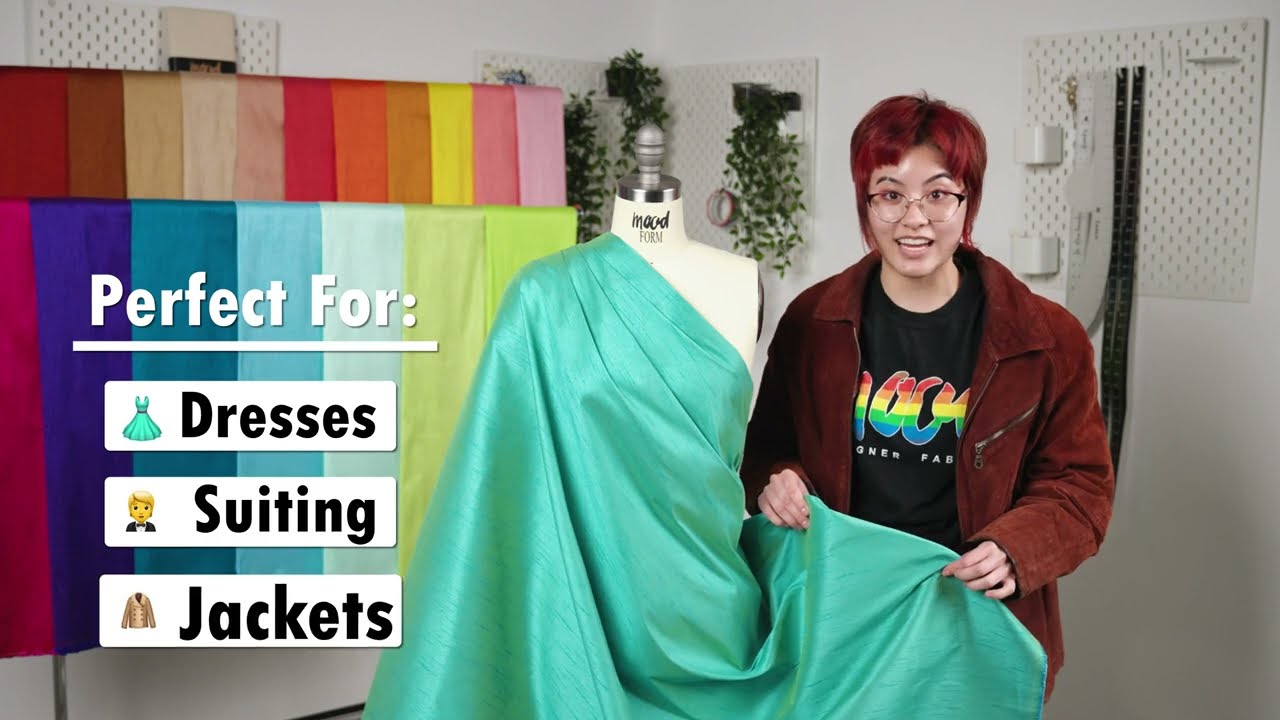Shantung fabric is a luxurious and versatile textile that epitomizes elegance and sophistication. Renowned for its distinctive texture and impeccable drape, this fabric is perfect for adding a touch of opulence to any project or garment. Crafted from a combination of silk and synthetic fibers, shantung offers the best of both worlds – the natural sheen and breathability of silk, combined with the durability and affordability of synthetic materials.
The unique weave of shantung fabric creates a stunning effect that is visually captivating. Its characteristic slubs, or irregularities, lend depth and texture to the fabric, making it truly stand out. Whether used for dresses, blouses, or home decor, shantung adds a touch of sophistication and luxury to any design.
What sets shantung apart is its incredible versatility. This fabric can effortlessly transition from casual to formal, making it suitable for a wide range of occasions. Its lightweight nature ensures comfort, while its natural draping properties allow for graceful movement and a flattering fit. Additionally, shantung is easy to care for, requiring minimal maintenance.
Indulge in the beauty and allure of shantung fabric and elevate your creations to new heights. Whether you are a fashion enthusiast or a creative designer, shantung is sure to captivate your imagination and inspire your next masterpiece. Experience the luxurious feel and timeless appeal of this exquisite fabric, and let its elegance shine through in your designs.

The Elegance of Shantung Fabric
Shantung fabric is a type of silk fabric that is renowned for its unique texture and elegant appearance. With its characteristic slubbed texture and slight sheen, shantung fabric has become a popular choice for various fashion and home decor applications. In this article, we will delve into the origins of shantung fabric, its distinctive features, and its versatile uses.
Origins and Production
Shantung fabric originated from the Shandong province in China, where it was traditionally made by weaving silk threads in a plain weave pattern. The name “shantung” was derived from the province’s old name, Shan-tung. Today, shantung fabric is also produced in other parts of Asia, such as India and Thailand, as well as in some Western countries.
Shantung fabric is primarily made from natural silk fibers, which are obtained from the cocoons of silkworms. These fibers are then spun into fine threads and woven together to create the fabric. The slubbed texture of shantung fabric is a result of the irregular thickness of the silk threads used in its production. This irregularity gives shantung its unique appeal and makes it stand out from other silk fabrics.
Distinctive Features
Shantung fabric has several distinctive features that set it apart from other textiles. One of its most notable characteristics is its slubbed texture, which is caused by the irregular thickness of the silk threads. These slubs create a subtle yet eye-catching pattern that adds depth and dimension to the fabric.
Another feature of shantung fabric is its slight sheen, which gives it a luxurious and elegant appearance. This subtle sheen enhances the fabric’s visual appeal and makes it suitable for formal and special occasion wear. The combination of the slubbed texture and the subtle sheen make shantung fabric a versatile choice for both day and evening attire.
Additionally, shantung fabric is known for its durability. Silk, the primary material used in its production, is known for its strength and resilience. This makes shantung fabric resistant to tearing and stretching, ensuring that garments made from this fabric will stand the test of time.
Uses in Fashion
Shantung fabric has long been a popular choice in the fashion industry. Its unique texture and elegant appearance make it a favorite among designers for creating formal and special occasion garments. Shantung fabric is commonly used for tailored suits, evening gowns, cocktail dresses, and bridal wear.
The versatility of shantung fabric is evident in its ability to be both dressed up and dressed down. It can be used to create chic and sophisticated outfits, as well as more casual and relaxed looks. This adaptability has made shantung fabric a staple in many fashion collections.
Home Decor Applications
In addition to its uses in fashion, shantung fabric is also popular for various home decor applications. Its elegant appearance and durability make it an excellent choice for curtains, drapes, upholstery, and decorative pillows. The subtle sheen and slubbed texture of shantung fabric can add a touch of sophistication to any room.
Shantung fabric is also used in creating table linens, such as tablecloths and napkins, for special occasions and formal dining settings. Its luxurious feel and visual appeal make it an ideal choice for adding a touch of elegance to any dining experience.
Care and Maintenance
Shantung fabric requires special care to maintain its beauty and longevity. Due to its delicate nature, it is recommended to dry clean shantung garments and home decor items. Avoid washing shantung fabric at home, as it may result in shrinkage or damage to the fabric.
If necessary, spot cleaning can be done by using a mild detergent and a soft cloth. However, always test a small, inconspicuous area of the fabric before applying any cleaning solution to the entire garment or item.
When storing shantung fabric garments, it is important to avoid hanging them on wire hangers, as they may cause the fabric to stretch or lose its shape. Instead, opt for padded hangers or fold the garments neatly and store them in a cool, dry place.
In conclusion, shantung fabric is a luxurious and versatile textile that is prized for its unique slubbed texture and elegant appearance. From high-end fashion to home decor applications, shantung fabric adds a touch of sophistication to any project. With proper care and maintenance, garments and home decor items made from shantung fabric will continue to impress for years to come.
Introducing the Alluring Eirian Shantung Collection by Mood Fabrics
List about Fabric Shantung
Fabric Shantung Table
| Property | Description |
|---|---|
| Fabric Name | Shantung |
| Composition | 100% Silk |
| Weave | Plain Weave |
| Weight | Lightweight |
| Texture | Firm and crisp with a subtle slub effect |
| Appearance | Lustrous, yet matte finish |
| Color Range | Vibrant and rich colors available |
| Usage | High-end fashion garments, evening wear, bridal gowns, drapery, and home decor |
| Care Instructions | Dry clean only, avoid direct sunlight |
Shantung, a luxurious fabric, is highly regarded in the fashion industry for its exceptional quality and timeless appeal. This 100% silk fabric is created using a plain weave technique, resulting in a lightweight material that drapes beautifully. Its firm and crisp texture, combined with a subtle slub effect, adds a unique touch to any garment or home decor item.
With a lustrous yet matte finish, shantung fabric exudes elegance and sophistication. It is available in a wide range of vibrant and rich colors, allowing designers to create stunning pieces that catch the eye. From high-end fashion garments and evening wear to bridal gowns and drapery, shantung fabric adds a touch of luxury to any project.
To maintain its exquisite appearance, shantung fabric requires special care. Dry cleaning is recommended, as washing may cause the fabric to lose its sheen. Additionally, it is advisable to avoid exposing shantung fabric to direct sunlight to prevent fading.
In summary, shantung fabric is a top choice for those seeking a refined and opulent material. Its exceptional properties and versatility make it a favorite among designers and decorators alike, ensuring its enduring popularity in the world of textiles.

